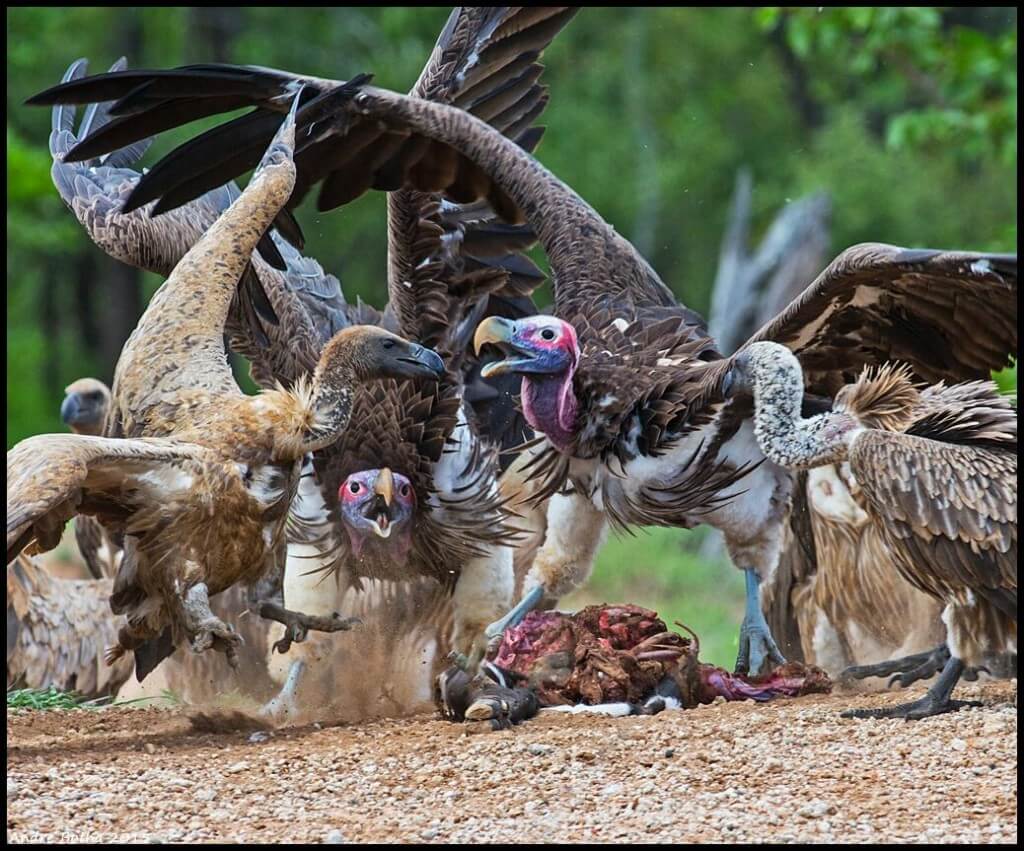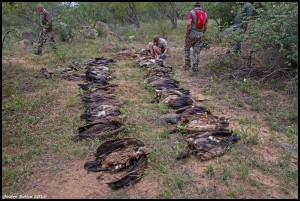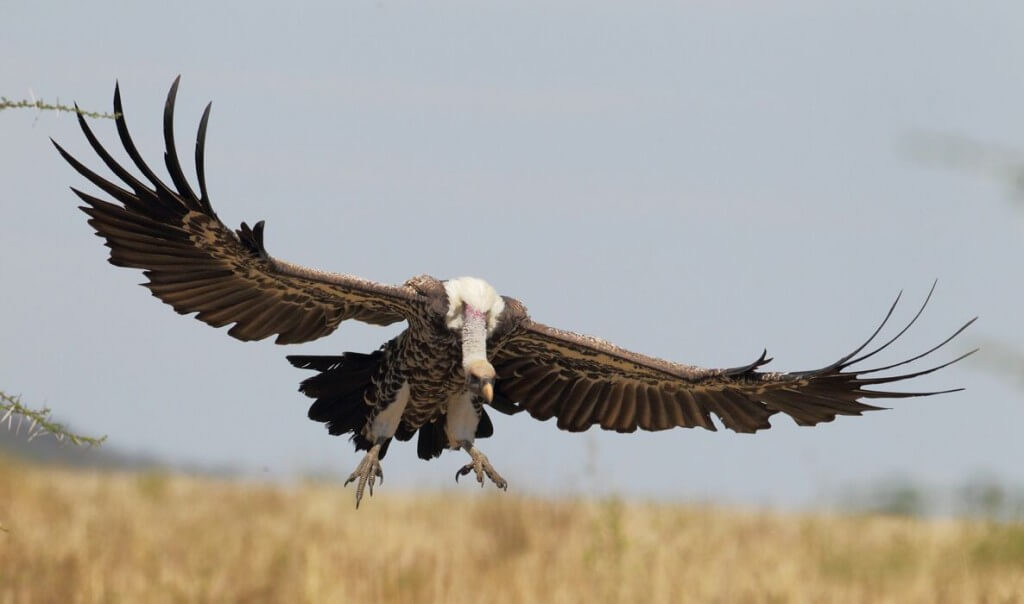
In a paper published today in the scientific journal Conservation Letters, scientists say African vultures are likely to qualify as ‘Critically Endangered’ under the International Union for Conservation of Nature’s global threat criteria.
The study indicates that Africa’s vultures are declining at rates of between 70% and 97% over three generations; a time interval used by the International Union for Conservation of Nature (IUCN) when assessing a species’ threat status. Since six of the eight species are largely or wholly confined to Africa, and are projected to decline by at least 80% over three generations, the study suggests that they are likely to qualify as ‘Critically Endangered’ under the IUCN’s global threat criteria.
The study estimated rates of decline (over three generations) for the following eight vulture species: Bearded Vulture Gypaetus barbatus (-70%), Egyptian Vulture Neophron percnopterus (-92%), White-backed Vulture Gyps africanus (-90%), Rüppell’s Vulture Gyps rueppellii (-97%), Cape Vulture Gyps coprotheres (-92%), Hooded Vulture Necrosyrtes monachus (-83%), Lappet-faced Vulture Torgos tracheliotos (-80%), White-headed Vulture Trigonoceps occipitalis (-96%).
Dr Darcy Ogada of The Peregrine Fund and lead author of the study, said:
‘Large declines of Africa’s vultures should ring alarm bells due to their immense ecological importance. Vultures are a vital component of a healthy environment, especially in Africa, where ‘free’ ecosystem services such as disposal of carcasses and other waste products remain the norm. If we don’t take urgent steps to save these birds, and in particular to curtail wildlife poisoning, we should expect long-term consequences for the environment, as well as for humans in Africa.What makes our results so concerning is that national parks and game reserves appear to offer these birds very little effective protection. Because vultures are so mobile and can easily travel hundreds or thousands of kilometres, decline rates were worryingly high even within protected areas.’.
Continent-wide declines in vulture species have already been reported in four Asian vulture species. However the study’s authors highlight two important distinctions between the Asian vulture crisis and that in Africa. First, to date, the rates of decline evident in Africa have been substantially lower than in Asia, affording African governments a window of opportunity in which to head off the environmental consequences of a collapse in this functionally important group.
Second, while Asian vultures have declined largely as a result of a single factor (ingestion of the anti-inflammatory drug Diclofenac), African vultures face multiple threats. They include incidental and deliberate poisoning, the illegal trade in vulture body parts for traditional medicine, killing for bushmeat, mortality caused by power lines and wind turbines, and a reduction in habitat and the availability of food from wild game populations.

incident at Derby farm, Limpopo,
South Africa, 7 May 2015.
The study suggests that the greatest quantifiable threat to Africa’s vultures is poisoning, which accounted for 61% of all reported deaths. African vultures are often the unintended victims of poisoning incidents, in which carcasses are baited with highly toxic agricultural pesticides to kill livestock predators. However the study also shows that the recent rapid increase in elephant and rhino poaching throughout Africa has led to a surge in the number of vulture deaths recorded, as carcasses have been poisoned specifically to eliminate vultures, whose overhead circling might otherwise reveal the poachers’ illicit activities.
The paper’s authors are:
Darcy Ogada1,, Phil Shaw2, Rene L. Beyers3, Ralph Buij4, Campbell Murn5, Jean Marc Thiollay6, Colin M. Beale7, Ricardo M. Holdo8, Derek Pomeroy9, Neil Baker10, Sonja C. Krüger11, Andre Botha12, Munir Z. Virani13, Ara Monadjem14 and Anthony R. E. Sinclair15 and their affiliations are:
1. The Peregrine Fund, 5668 West Flying Hawk Lane, Boise, Idaho, 83709, USA and, National Museums of Kenya, Nairobi, Kenya
2. School of Biology, University of St Andrews, Fife, KY16 9TH, UK and, Institute of Tropical Forest Conservation, Mbarara University of Science and Technology, Kabale, Uganda
3. Biodiversity Research Centre, University of British Columbia, Vancouver, BC
4. Department of Animal Ecology, Alterra Wageningen University and Research Centre, Wageningen, Netherlands
5. Hawk Conservancy Trust, Andover, Hampshire, SP11 8DY, UK and, Centre for Wildlife Assessment and Conservation, School of Biological Sciences, University of Reading, Berkshire, UK
6. Centre National de la Recherche Scientifique, Museum National d’Histoire Naturelle, Paris, France
7. Department of Biology, University of York, Wentworth Way, York, UK
8. Division of Biological Sciences, University of Missouri, Columbia, MO, USA
9. Department of Biological Sciences, Makerere University, Kampala, Uganda
10. Tanzania Bird Atlas, Iringa, Tanzania
11. Ezemvelo KwaZulu-Natal Wildlife, Cascades, South Africa
12. Endangered Wildlife Trust, Modderfontein, South Africa
13. The Peregrine Fund, 5668 West Flying Hawk Lane, Boise, Idaho, 83709, USA, National Museums of Kenya, Nairobi, Kenya
14. Department of Biological Sciences, University of Swaziland, Kwaluseni, Swaziland
15. Beaty Biodiversity Research Centre, University of British Columbia, Vancouver, Canada

studies in West and East Africa
suggest that populations of Rüppell’s
Vulture are declining at a rate of
about 97% over three generations
(or 56 years).
[registration_form]
Sadly, although the window of opportunity for action may be greater than it was for Asian vultures, the causal factors identified are rather more intractable, particularly given the large number of different countries involved. This is very grim news indeed.
It is indeed very grim news. As I understand it often the poison of choice is our old friend Carbofuran– perhaps it should be banned worldwide. Then why does a a pesticide banned on the first world find a market in Africa?!
That’s our ethical big pharma for you. Banned in one market, move on to the next.